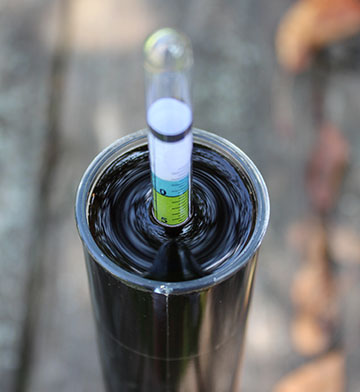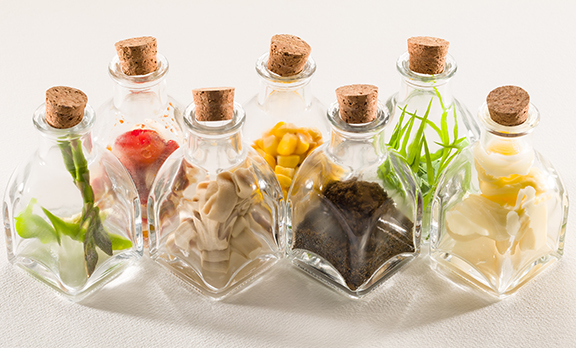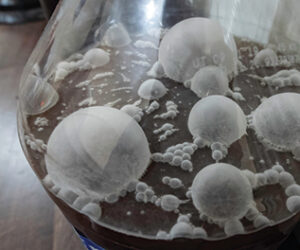
A fermentation is “stuck” when it fails to reach the desired conversion level of sugar, usually coming to a halt somewhere below 10 °Brix. It does not refer to a failure to start, which is a different issue. I used to have a lot of stuck fermentations at home but really haven’t had a problem for the last decade or more as my techniques improved: Hydration nutrient, two-step nutrient addition and the like. But last year was a disaster in the basement — 30 gallons (114 L) of Traminette, 15 gallons (57 L) of Cayuga White, and 6 gallons (23 L) of Chardonnay stuck for reasons unknown (which is usually the case). I had to use every trick I knew to salvage them and I figured it would make a good lesson for other home winemakers.
First, some background
Brix is a density scale based on sugar in water, but it only indirectly measures sugar. Other dissolved solids like acids increase Brix, while ethanol (with a specific gravity of 0.790) decreases Brix since it’s lighter than water (which has a specific gravity of 1.000). A complete fermentation will typically give a Brix between -1.2 and -1.8; let’s use -1.5 °Brix as an average. Therefore, if you ferment to 0.0° Brix, you have about 1.5% sugar left.
The desired residual sugar is a function of personal taste and the acid level: Dry for most reds and often some sugar is desirable in whites, especially for cooler-climate vinifera grapes like those I work with in New York State, as well as in wine from hybrids. Commercial wineries have the equipment to stop fermentations at the desired sugar level as opposed to fermenting to dryness and back-sweetening to taste. I recommend the latter for home winemakers who want some residual sweetness in their wines — it’s a whole lot easier to hit the desired sweetness level, and the difference in taste between the two techniques is pretty subtle.
As you’ve seen, there are hundreds of different yeasts out there from various manufacturers. Focusing on white wines now, on my batches of the Traminette I used three different yeasts — what I would call a strong, a medium, and a weak yeast — EC-1118, often used to restart the cuvée for sparkling wine; W15, which is a good all-around performer; and CEG (Epernay II), which is gentle and used because it’s easy to stop. One trick you can use for residual sugar is using these or similar three yeasts on different batches of the same wine, hoping the first two yeasts will ferment dry and the CEG will leave some residual sugar. Then you can blend to taste.
Unfortunately, in my fermentations last year, the EC-1118 came out 1.0 °Brix (2.5% sugar). The W15 was 2.5 °Brix, and the CEG was 4.0 °Brix. From past experience, I knew I wanted between 0.5 and 0.0 °Brix. The Cayuga White (all fermented with CEG) was also 4.0 °Brix and the Chardonnay (fermented with W15) was 2.9 °Brix.
Every trick I knew
The first step with this problem is fairly safe — splash rack and warm. Fermentations can get too low in O2, so stir lightly to pick up some of the lees and rack so the wine spreads out over the inside wall of the receiving carboy. Of course, don’t use sulfite during any of these steps. Take the carboys to a warm area (72–78 °F/22–26 °C) and let them sit for a week. Alternatively, you could bring the warmth to the carboys if it is easier; using an electric blanket, heat pad, space heater, or heating the carboys by other means. This method may get fermentation started again and has worked for me in the past, but not this time.
At this point, you’re going into a salvage operation. Share some samples with your significant other or your drinking buddies and ask, how bad is it? If it’s not broken, don’t try to fix it. Or if you have something else that needs sweetening, it may make a great blending wine. If the answer to the first question is “yuck” and the answer to the second is “no,” then proceed. Unfortunately, this is where I found myself last year. So, proceed I did.
For each type of wine, you’ll need to make a starter. Take one quart (1 L) of water, 100 grams sugar, and one quart (1 L) of the stuck wine in a 1-gallon (4-L) jug. (We’ll call the stuck wine “must” even though it’s not really accurate terminology.) Hydrate a pack of EC-1118 yeast and add to the starter mix. (EC-1118 is one of the primary yeasts used for restarting a cuvée to make Champagne. Another option to consider is Uvaferm 43, another yeast specifically designed for restarting fermentations.) You can use a simple water rehydration as described on the yeast packets but it is better to use a rehydration nutrient such as Go-Ferm. By suspending Go-Ferm in the rehydration water, the yeast will soak up bio-available micronutrients as they rehydrate. This optimizes nutrient availability; enhancing yeast growth and protecting against alcohol and other adverse factors. Keep the jug warm and hopefully you’ll be bubbling in a few days.
Although I didn’t use them in the current case, the addition of yeast hulls to the must prior to the re-inoculation step is another possibility to promote fermentation. Yeast hulls are highly beneficial in oxygen-deficient juice and wine as they contribute sterols and unsaturated fatty acids. Some good choices would beSIY Cell Hulls and Reskue, both from Lallemand.
Once the starter is bubbling well (a bubble every five seconds) add one more liter of must. Yeast only convert sugar when they are crowded, so every time you dilute with more must, it may take them a while to get going again. Next, dump the jug into a 5-gallon (19-L) carboy and add 1.5 quarts (1.5 L) of must. Wait until it’s going, then add about 2 quarts (2 L) more of must. This is a critical point. Whatever the yeast didn’t like is still there and if you add more than half the fermenting volume at one time, you’ll likely shut the process down again. Keep going until all the must is transferred. By this point, I should mention that this technique has worked for me every time in the past — until this year.
At this point I was desperate so I went to my supplier’s website and ordered more EC-1118 and a Gewürztraminer Grand Cru wine concentrate kit. EC-1118 happened to come with the kit but if not, I would have substituted it or Uvaferm 43. I made up and inoculated the 6-gallon (23-L) kit per the manufacturer’s instructions and waited several days until it was fermenting merrily (split between two 5-gallon/19-L carboys). I then divided the 6 gallons (23 L) into three 5-gallon (19-L) carboys: 31⁄2, 2, and 1⁄2 gallons (13, 8, and 2 L) for the Traminette, the Cayuga White and the Chardonnay, respectively. I then began adding the stuck wine per the earlier instructions, a half volume of each at a time, and waited for bubbling to resume. When fermentation was active in a full carboy, I’d split it into two carboys and resume adding wine. I tried to keep the average temperature in the low 70s °F (low- to mid-20s °C), near the wood stove but not too near.
It took a long time — over four weeks — but it worked. The Traminettes and Cayugas range from 0.1 to -1.7 °Brix and taste great. They have been sulfited, Sparkolloided, and put in the cellarway stairs to chill. The Chardonnay is at 0.1° Brix and I’m hoping I can get it down a little more. Chardonnay typically has lower acid than the other two and drier is better.
I specifically chose the Gewürztraminer kit because I knew the flavor would blend well with the Traminette and Cayuga. I’m not so sure about the Chardonnay, but the final Gewürztraminer addition will account for less than 10% (2 quarts in 61⁄2 gallons/2 L in 25 L) so it should be okay. Had I been making a larger batch of Chardonnay and risked losing more than 6 gallons (23 L) of wine, I likely would have purchased a second wine kit of Chardonnay that would have been a more appropriate blender for my stuck wine.
After the blending process between carboys was over I did end up with an extra 5 gallons (19 L) of assorted wines, which I just blended all together and bottled. As frequently happens, that will be likely the medal winner that I can never reproduce!
While stuck fermentations don’t happen often, when they do it is important to know how to get them re-started before it is too late. Maybe it will only take one of these methods to restart your next stuck fermentation, but in case, like for me, you run into a difficult situation where your wines just will not ferment to dryness, it’s good to be able to have many tricks and methods to get things going again.
Related Links:
• Every winemaker has slightly different approaches for their winemaking, and how they deal with stuck fermentations is no different. WineMaker’s Technical Editor Bob Peak has written about his own steps he takes in the case of a stuck fermentation, which digital members can find online at https://winemakermag.com/technique/restart-stuck-fermentation
• The Wine Wizard has answered many questions regarding stuck fermentations over the years. In this question, she dives into the potential causes of fermentations failing to finish, as well as offering her advice on what to do when two blueberry wines finish at different gravities: https://winemakermag.com/wine-wizard/1376-stuck-fermentations-wine-wizard







